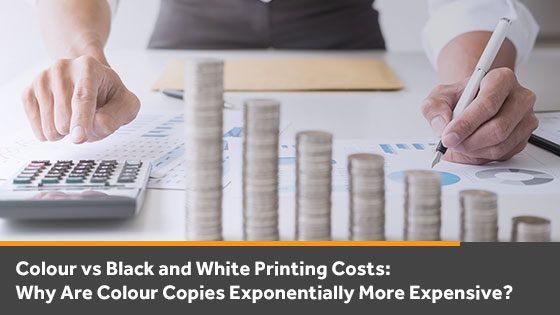If you have ever purchased new ink or toner for your printing devices, then you have witnessed first-hand the difference in colour vs black and white printing costs. Colour copies always cost significantly more than black and white copies.
Why is the cost of copies so dependent on whether you choose to print in colour or not?
Does coloured toner have special ingredients that cost more than basic black toner? Is there a dire shortage of colour toner cartridges that drives up the price for consumers? Many possible explanations come to mind.
Let’s investigate why the cost of printing changes so much when you choose to print in colour rather than black and white.
Colour Copiers Use Multiple Cartridges
Printers and copiers use a standardized set of four different toner cartridges. There is a black cartridge, a yellow cartridge, a magenta cartridge, and a cyan cartridge. These four cartridges work together to create the full range of colours that you see on the page once the printing is complete.
Printing in black and white uses only the black toner cartridge and the white space on the paper to produce the image. Printing in colour uses all four toner cartridges to create bright, colourful images and the additional cartridges applied means more toner is consumed per page. However, you are right to believe the cost of printing colour copies has more to it than just the number of cartridges used.
Colour Printing Mixes Multiple Toners
When you print a colour document or image, you are not merely choosing to use one colour cartridge instead of a black cartridge. In fact, to create some colours, you may be using all cartridges at once. Instead of just depleting one cartridge, you could be draining all four. This means that cartridges will deplete faster and, ultimately, need to be replaced more frequently.
Four toner cartridges used for a colour print means colour prints should be four times more expensive than black and white prints, right? On the surface, that assumption makes sense. However, the final cost is not as simple as counting how many toner cartridges were used.
Still, using all the cartridges doesn’t quite explain why the cost per copy (CPC) is so much higher for colour copies. There is still one more piece of the puzzle we must add.
Pages Printed in Colour Leave Less White Space
We know you need more toner cartridges in a colour printer. We also know you may be using multiple colours of toner at once to create a colour image. All of this raises the CPC rate for colour copies.
The final consideration that often plays a significant role in colour vs black and white printing costs is the type of image you are printing. Think about the kinds of documents or graphics you would print in colour and then think about the types of documents or images that you would choose to print in black and white.
The type of printing you will typically do in black and white is document printing. Black letters on a white page are simple and leave a lot of white space on the page. Therefore, these print jobs do not require a lot of toner. However, your colour print jobs are likely fuller and more detailed when compared with black and white printing.
Even a simple page with a pie graph that uses different colours to show different variables can consume significantly more toner than a black and white document. It is even possible that all four toner cartridges could be working at once to fill in the image with various colours.
Not only are you using multiple cartridges at once, but you are often using significantly more of each colour on each page printed in colour.
This is referring to what is known as page coverage, or the percentage of a page’s white space covered by toner. Black and white text typically leaves much more white space than the rich image, table or graph that you might be printing in colour.
This is why the colour CPC rate is often more than four times the CPC rate for black and white copies. There are several variables at play that all need to be averaged into the total cost.
Costing Based on Averages
Since the quantity of toner used for each impression (page printed) can vary so wildly, the CPC costing formula is based on the average page coverage, toner usage and cartridge wear for each page printed.
While this may be frustrating when you are billed for a colour impression on a page with just a few words or lines in colour, it is necessary to keep the billing process smooth and efficient for both yourself as the end-user and your service provider.
Should You Buy a Colour Copier?
To ultimately answer whether you should buy a colour copier you need to ask yourself two questions:
- What is the primary purpose of your device? Will you print documents solely text documents or do you need to produce visual reports, brochures, marketing materials, etc.?
- When you currently print in colour, is the colour printing required to operate your business?
If you determine that your colour printing is primarily for convenience purposes but you do not want to completely give up the ability to print in colour, you can reduce your service contract (CPC) rates by purchasing a black and white copier and supplementing the ability to print in colour with a small desktop dedicated colour printer.
Desktop printers require less service, are much less expensive to purchase and are more than suitable for small volume, convenience printing.
On a quest to reduce your overall printing costs? You need to read our Complete Guide to Controlling Printing Costs!
Cory Porteous
Director of Marketing & Inbound Business Development
Office Interiors




